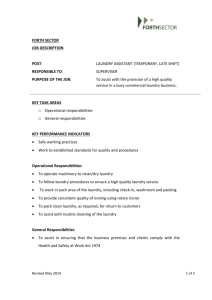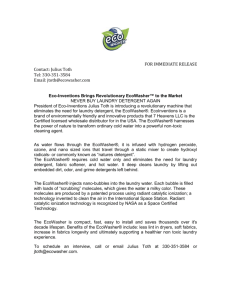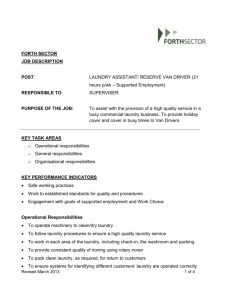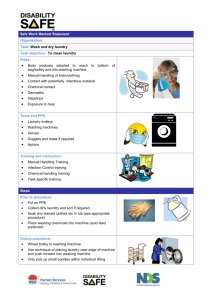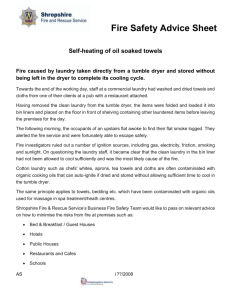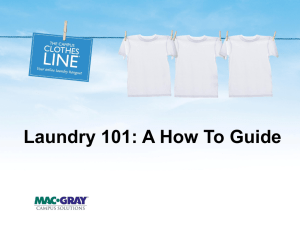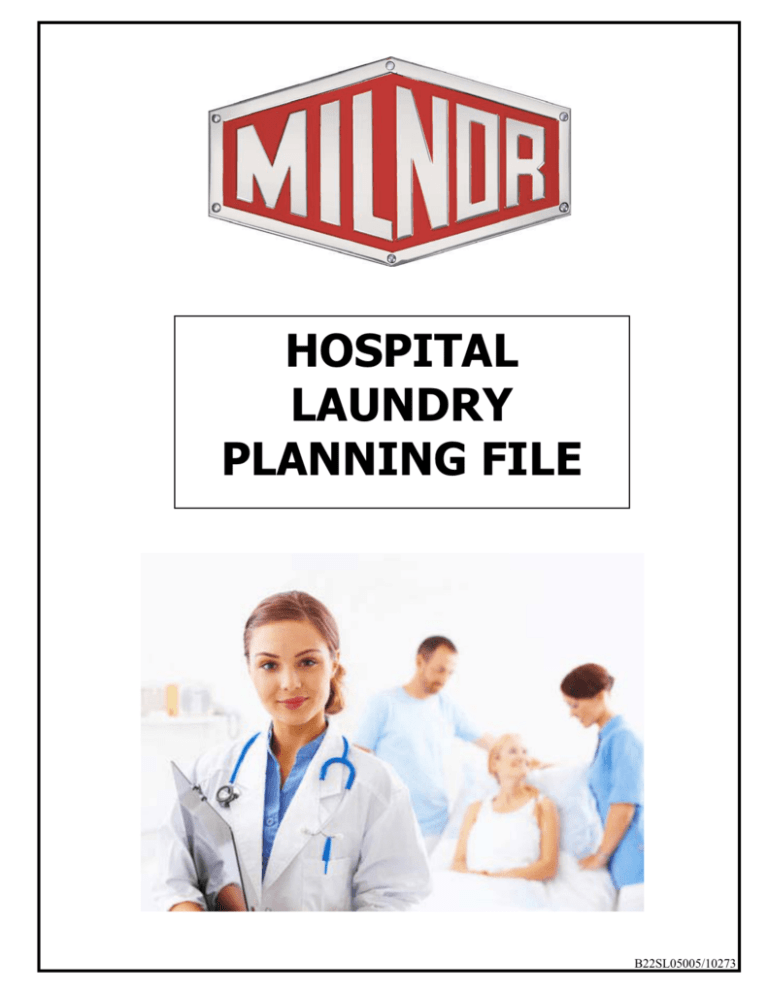
HOSPITAL
LAUNDRY
PLANNING FILE
B22SL05005/10273
Laundry Systems
for healthcare institutions
WHY INSTALL AN ON-PREMISES HEALTHCARE LAUNDRY?
1. Launder everything on premises.
A MILNOR on-premises laundry can handle all of a healthcare institution's clean fabric needs in a simple
manner. MILNOR washer-extractors can process patient gowns, pajamas and personal apparel, adult
diapers, towels, linens, mattress covers, blankets, pillows, plus such items as employee uniforms, slip covers
and cleaning rags. Many types of rugs and drapes can be processed in a MILNOR on-premises laundry.
2. Enhance the image of your institution.
Many operators have enhanced their image of quality, and brightened their patient's environment, through
tasteful fabric selection. Everything from linen to drapes can be selected in the colors and patterns of your
choice and processed in your MILNOR equipment.
3. Get more use from less inventory.
An on-premises laundry provides more use from less inventory. Smaller stocks meet your needs since you
are no longer dependent on pickup and delivery. Towels, linens, and patients' apparel can be laundered
immediately after use and be ready again in about an hour if necessary. Smaller inventories mean less
storage space and more money for investment elsewhere.
4. You won't be caught short.
On-premises laundering eliminates "caught short" situations. It gives you a ready supply of adult diapers,
linens, towels, patient gowns, and pajamas. This is especially important during weekends and holidays
when outside services are not available.
5. Control quality, sanitation.
On-premises laundering assures quality processing because you are in control. You can prolong fabric life by
using a distinct formula for the specific degree of soil. MILNOR's E-P Plus® washer-extractors make this
easy, with several specific formulas developed and field-tested by chemists for healthcare facilities. MILNOR
washer-extractors also combine commercial washing action with the ability to wash at high temperatures so
you can be sure sanitary safeguards can be maintained. MILNOR Staph Guard® washer-extractors, installed
in a wall separating clean and soiled areas, are available for medium and large sized institutions where
infection control is vital.
WHAT IS NEEDED FOR AN ON-PREMISES LAUNDRY?
1. Equipment
Operating a healthcare on-premises laundry is simple. Washer-extractor, dryer, sink, folding table, and
supplies are generally all you need. Often, an institution's existing hot water, gas, and electrical services
are sufficient. An on-premises laundry is basically an extension of your present services.
A top quality washer-extractor, with a proven track record in commercial use, brings professional laundering
ability to your institution. It will make better use of water and soap, improve washing quality, and handle
bulky items. It's best to get a machine with a large cylinder, which provides the ability to launder items
such as diapers, mop heads, and cleaning rags.
Dryers can use gas, steam or electric heat (gas is regarded as the most efficient). For faster drying and less
wrinkling of polyester materials, it is generally desirable for the dryer to be rated at a slightly larger capacity
than the washer-extractor. An area for folding is necessary, too. A 2' x 6' table proves sufficient for most
institutions. After folding, the items simply have to be stored.
2. Space
An on-premises laundry doesn't require much space. An equipment room or an existing linen storage room
is adequate for many facilities. An unproductive room with a poor location may also be used or a
combination of these rooms could be used in a large institution. A larger, central laundry can serve affiliated
facilities near each other. A MILNOR dealer's laundry planning department provides specially prepared
layout drawings for facilities at no charge.
3. Labor
In some institutions there is no need for additional help. Existing housekeeping and maintenance employees
can handle the laundry during the slower parts of the day. Equipment that is easy to operate is essential to
maintain consistent quality and production. MILNOR's E-P Plus machines are particularly easy to use. The
operator simply loads the machine, pushes a button to select the formula, pushes the start button, and can
go on to other tasks since the machine requires no more attention.
WHAT SHOULD YOU LOOK FOR IN A WASHER-EXTRACTOR?
1. Easy operation
The washer-extractor you select should have easy, automatic controls that make operation simple and free
the operator to handle other duties. With MILNOR's preprogrammed E-P Plus machines, the operator
simply matches the type of goods being loaded to the formula named for these goods ("towels", for
example), then pushes a button. Operation of field-programmable formulas is similar. Formulas on the
alphanumeric display can be named to match goods, making selection easy. Because so little judgment is
required, new employees get the knack quickly. Substitute employees can take over with ease, too.
Automatic supply injection further reduces operator responsibility and helps ensure consistent quality.
MILNOR machines readily accept liquid chemicals, making hookup fast and easy. Other factors to look for
are a large, accessible door for fast loading/unloading, and door safety interlock which prevents opening
while the machine is operating.
2. Laundering quality
Washing flexibility should not be sacrificed for operation simplicity. Only a commercial washer-extractor,
with professional tumble washing action, can properly clean stained linen, soiled diapers, and dirty apparel.
A cylinder with a large diameter should be among the top priorities when choosing a washer-extractor. The
large diameter provides the lift and drop action necessary to clean hard-to-launder items. When comparing
machines, compare actual cylinder dimensions and specific cubic foot volumes.
Also, look for microprocessor controls which give a greater range of processing choices as well as more
accurate control over how goods are processed. The preprogrammed formulas in MILNOR machines were
developed specifically for the needs of healthcare facilities. They are not common-denominator formulas.
The formulas differ in number, type, time and temperature of baths, as well as supply injection. By pushing
a button, these formulas can be adjusted for either permanent press or all-cotton fabrics. The machines are
available in 25 to 160 lb. capacities.
3. Heavy duty construction
Rugged construction -- from top quality materials -- is imperative if you expect long-term service. Check
competitive brands to see if their construction stands up to MILNOR specifications. Compare spec literature.
There can be a big difference in quality.
MILNOR machines stand apart from others with features like:
x large, tapered roller bearings and a triple shaft seal to shield the bearings from water
x the exclusive use of continuous, rather than spot, welding for greater strength and reliability
x the simplicity and dependability of heavy duty, single-speed motors
x pre-extract load balancing speed to reduce vibration and extend machine life, and
x a console constructed of heavy gauge materials
JUNE 2010
HSHS Shared Laundry Services consolidates laundry for 10 hospitals
New plant serves institutions in
Central and Southern Illinois
BY BRUCE BEGGS, EDITOR
SPRINGFIELD, Ill. — HSHS Shared Laundry
Services has been up and running for more than
six months and by early 2011 will be responsible
for supplying the laundry services for 10 hospitals
in Central and Southern Illinois.
The new facility on the northeast side of Illinois’
capital occupies a former tanning supply warehouse. Its location just off I-55 offers easy highway
access to any of the hospital customers within its
roughly 120-mile service area.
As the on-premise laundries serving the
Hospital Sisters Health System’s (HSHS) various
Illinois hospitals deteriorated with age over the
past decade, the prospect of a centralized laundry
became a more frequent topic of conversation,
says Mark Davis, the laundry’s director. But it wasn’t until a feasibility study illustrated the benefits of
such a setup that the decision to consolidate was
finally made.
Headed for 10 Million Pounds
At the time of our visit, the 28,000-squarefoot laundry was processing approximately 4.8
million pounds annually for St. John’s Hospital
in Springfield (owner of the shared-services
facility), St. Mary’s Hospital in Decatur, and St.
Francis Hospital in Litchfield—part of HSHS—
plus Dr. John Warner Hospital in Clinton and
Pana Community Hospital. It was at roughly
50% capacity, and some of the washing and
flatwork-finishing equipment was idle because
the workload didn’t justify its use.
The laundry will add St. Mary’s Hospital in
Streator in July, followed by St. Elizabeth’s
Hospital in Belleville, St. Joseph’s Hospital in
Breese, St. Joseph’s Hospital in Highland and,
finally, St. Anthony’s Memorial Hospital in
Effingham by the first of the year, Davis says. All
are HSHS institutions.
The added poundage will push the laundry’s
workload to approximately 10 million pounds
annually, but there may still be some capacity
remaining to consider taking on additional
accounts, he adds.
Carl Rees, who oversaw the HSHS laundry project for suburban St. Louis-based distributor
Loomis Bros. Equipment Co., quipped that he
hopes the plant doesn’t take on too much more
work, since 10 million pounds is what it was
designed to process.
Davis and Rees have been friends for 20 years
and had many conversations about the health
system’s laundry needs. Both say they are
pleased to have seen the project they envisioned
finally come to life.
Two eight-module tunnel washers anchor the plant. HSHS is using only one
until other hospital customers are brought into the fold.
Central Laundry Deemed Most Cost-Effective Choice
“All the hospitals (once) had their own laundry,” Davis says of the HSHS institutions. “But the
hospitals didn’t put the capital into them over the
years, so all the facilities were needing upgrades.”
For example, one hospital still uses an ironer that
was installed new in 1961 and later rebuilt,he explains.
“Corporate decided to do a study and see if they
wanted to put (laundry) funding into the hospitals
or if it would be feasible to build a central laundry,
put all the capital money into this, and truck it out.”
In 2007, a consultant was hired to examine different scenarios, including possibly upgrading the
St. John’s Hospital OPL to handle the workload
generated by multiple facilities.
“They decided that building a central laundry
would be more cost-effective, more feasible, than
up-grading or trying to upgrade a facility already
there to do it all,” Davis says.
The decision to proceed with the central laundry was made in early 2008 and announced to the
system’s hospitals late that year.
There was some debate about whether to build
the laundry in Springfield or in Decatur some 40
miles to the east, but when the warehouse building
became available, its proximity to the health system’s corporate office and its highway access made
Springfield the ideal choice.
The laundry operates a single, 8-hour shift
Monday through Friday (deliveries occur Monday
through Saturday). There are 37 employees, with 28
working in production, two in maintenance, three
drivers, and a secretary. Don Beahringer is operations manager, and Jim Bishop is chief engineer.
Because there is more office space available than
the laundry needs, some of the health system’s corporate staff members are headquartered there, too.
Project Focus: Green Operations
and Equipment Redundancy
Based on a consultant’s plan, HSHS solicited
bids from vendors and selected Loomis Bros. to
head up the project, Davis says.
“We basically handled all the project management” after the health system selected a construction firm, says Rees, who is Loomis Bros.’ vice president of sales.“We put together all the layout drawings, the installation drawings, and engineered the
entire laundry.”
The project evolved through several different
layouts, according to Rees, until the final design
allowed for a minimization of worker movement.
Construction began in January 2009, and the
Reprinted from American Laundry News • Published by American Trade Magazines, a division of Crain Communications Inc.,
360 North Michigan Avenue, Chicago, IL 60601 — (312) 649-5200 © Copyright 2010 Crain Communications Inc. All Rights Reserved.
plant came online in November. The total project
cost was approximately $9 million.
The plant is anchored by two eight-module
Milnor CBW® batch washers. “They (HSHS) had
wanted as green a facility as they could get,” Rees
says. “And the poundage dictated that we went
with tunnel washers because they reuse the water.
“We also kept in mind that we wanted backup
in case we had any equipment failures or anything.
There’s a lot depending on what’s going on here, so
we decided that instead of a large tunnel washer,
we would go with a couple of 8-mod units. We’ve
got built-in backup there. The equipment has been
backed up everywhere.”
There is also a water-reuse system and a TEA
wastewater heat-recovery system in place elsewhere in the plant.
“We got it as green as we could, except for the
real expensive (water) purification system that
they decided not to go with at this point,” Rees
says. “It’s set up so if they want to add that in the
future, we can go there, too. That’s almost total
reuse and cleaning of the water.”
Equipment selection throughout the plant was
also based on the laundry’s estimated poundage
and the types of items it would be processing, Rees
adds. The plant required heftier water/sewer service than was supported by the former warehouse
site, and the electrical service was improved, too.
The clean take-away conveyor transports goods from the dryers.
The plant uses laundry chemicals and injection
systems made by Gurtler Industries and supplied
by H.H. Coleman. Two 200-hp Lattner boilers generate heat for the plant, while Kaeser compressors
supply the needed compressed air. Lintcollection and cart-wash systems are by Energenics.
Standardization Desired, But Specials Still a Must
An E-Tech automated rail system—completely
floor-supported, Rees points out during our
tour—is used to load the two eight-module, 150pound Milnor tunnels. Each tunnel has its own
single-stage extraction press, and there are four
275- to 300-pound dryers on each system.
Three stand-alone Milnor washer-extractors
(60, 170 and 275 pounds) and another 300-pound
dryer are available for rewash and small loads of
specialty items.
“We’re trying to standardize all the hospitals as
much as we can,” Davis says, “but there are
restraints and all kinds of paraphernalia that the
hospitals have that they want washed.”
The laundry purchases basic linen items from
Phoenix Textile. “Everybody uses the same sheets,
the same pillowcases, the same blankets.”
It doesn’t process mops and rags, so each hospital keeps small wash equipment on-site to process
those goods, Davis says.
come to Chicago,” says Carol Tyler, Chicago
Dryer’s marketing director, who also toured the
facility. “They can meet everybody who’s involved,
ask questions of the engineers, and see how everything is made.”
Chicago Dryer Equipment Dominates Finishing Area
The Milnor dryers automatically dump goods
to a conveyor that carries the just-dried linen to a
finishing area dominated by Chicago Dryer Co.
equipment.
The inventory list reads like a Chicago® showroom: two Pik-Quik linen separators with cart
shufflers; an Edge Maxx spreader-feeder; a King
Edge spreader-feeder; two 2-roll, 52-inch Century
ironers; one 2-roll, 42-inch Century ironer; two
Air Chicago small-piece folders; two Air Chicago
XL small-piece folders; a Skyline Mini folder; and
a Blanket Blaster blanket folder.
The folders and stackers are equipped with
Bridge linen-transition conveyors. The small but
integral machines extend their mini-conveyors to
discharge the folded items onto a master takeaway conveyor, which then carries the clean linen
to waiting pack-out workers. Sensors ensure the
stacks are spaced on the belt.
“You’ve got various pieces of equipment on one
belt, so you’ve got stacks of linen going by,” Rees
says. “If you’ve got a situation with a stack coming
up, instead of discharging and bumping into that
one, it stops the conveyor on the folder and lets
that stack go by.”
The entire system is tied into ChiLinc
(Chicago® Laundry Information Network
Connection). The data-collection system connects
the laundry’s management team to the flatwork
finishing systems, providing current and historical
production data, operator efficiency rates, and
individual machine utilization factors.
Rees and the Loomis team worked closely with
the manufacturer to analyze the laundry’s flatwork
needs and determine which equipment would fit
best to reach its production and quality goals.
“It was sized to keep it flowing and keep everybody busy,” Rees says. “That’s where you get your
production and keep your pounds per operator
hour up where they need to be.”
“Whenever possible, we like the customer to
Carl Rees (left), Loomis Bros. Equipment Co., and Mark Davis, director of
HSHS Shared Laundry Services, share a congratulatory handshake.
Pack-Out and Delivery
Clean linen is stacked and stored by the cartload
and moved to an interior staging area outside the
laundry. Dozens of loaded carts covered in clear
plastic fill this large room, where faxed or e-mailed
orders are filled and drivers wheel the carts into
their delivery trucks.
The hospital additions will require the cleanlinen staging area to be relocated at some point in
favor of adding more production space, Davis says.
The laundry uses three delivery trucks.
Springfield and Decatur deliveries are made daily,
while other facilities receive deliveries two or three
times a week.
Pleased with Outcome
“This is the largest job I’ve sold,” Rees says.
“We’ve done a lot of good-sized jobs, but generally
it’s (replacing) all the flatwork equipment or all the
washers. But to get the complete plant, with everything, that was huge. It was great for Loomis Bros.
“I’ve got a great relationship with Mark, and
have for a long time. That’s a lot about what this
is—you build relationships with people. Mark is a
friend more than he is a customer. It feels really
good that he’s happy with it and it has all worked
the way he wanted it to.”
Davis would like to form a committee of hospital representatives so the laundry’s customers can
provide feedback about the service, linen selection,
etc. Right now, they all have good things to say.
“Everybody is quite pleased with how things are
looking, how things are going,” he says. “There
really are no issues right now. Things are really
going very well.”
ALN
Associated Hospital Services and Pellerin Milnor: Improving for their
Customers
By: Scott McClure
Vice-President, Pellerin Laundry Machinery Sales Company
After being devastated by Katrina in 2005, Associated Hospital
Services (AHS), located in New Orleans East, has recently completed its
second equipment renovation. In August 2005 the laundry received 6’ of water
damage from the hurricane decommissioning most of the existing laundry
equipment. Despite the devastation, the laundry staff was determined to
rebuild the laundry and they were able to do so in less than 8 months. AHS
utilized Pellerin Laundry Machinery Sales Company, their authorized Milnor
distributor, to restore one of their existing Milnor CBW® Systems and re-equip
the laundry with additional Milnor and Chicago equipment.
In 2010, Associated Hospital Services completed a major equipment
renovation with the acquisition of a new Milnor CBW® tunnel with PulseFlow™
technology (their 5th Milnor CBW®), affirming the laundry’s dedication to
efficiency and savings. With this addition, the co-operative laundry is capable of
achieving pre-Katrina production capacities, while achieving significant
operational savings.
The cooperative laundry is currently producing in excess of 10,000,000
pounds of healthcare linen in only 40 hours per week, with less than 40
production employees. This calculates to an average PPOH of approximately
120. The new renovation will allow the laundry to continually increase their
PPOH and become even more efficient. These production achievements begin
with AHS’s dedicated employee base. Over 90% of their current employees
worked for AHS prior to Katrina. Associated Hospital’s employees are just as
dedicated to AHS’s full recovery as their managers.
The new renovation includes a Milnor 76039 8-Module CBW System with a 50 Bar Press and four Milnor
64058 pass-through gas dryers. The CBW has a new water saving feature called PulseFlow™. PulseFlow
Technology allows the 8-module system to process healthcare linen at approximately a 101 second transfer rate
while using 0.3- 0.4 gallons of water per pound. In simplified terms, Milnor still utilizes the superior True Top
Transfer counter-flow design that offers excellent dilution and bath separation. The PulseFlow design uses highvelocity counterflow through the wash zones, allowing chemistry, dilution and mechanical action more process
time. PulseFlow increases the throughput capacity of the CBW; thus, an 8-Module Milnor PulseFlow CBW
production is comparable to an 11-Module Milnor traditional, continuous counterflow CBW. Because the water is
not continuously run through the CBW, but pumped at a higher rate at an exact time, the tunnel washer uses less
water (gallons/lb.) to effectively process the linen.
After the PulseFlow CBW has cleaned the linen, the clean linen travels through a Milnor 50 Bar Press and
to one of the four 64058 pass-through dryers via a Milnor 2-tier
shuttle. Then, the clean, dry linen travels on an incline conveyor and
into awaiting laundry carts. Associated Hospital staff use Chicago
flatwork machinery to process various types of healthcare items for
distribution.
Along with the PulseFlow CBW® system, Associated
purchased two additional ironer lines. All three of the laundry’s large
piece ironing lines include Chicago Edge feeders and Skyline Folders
with Stackers. Their small piece ironing line includes a Chicago
Skyline SP-4 four lane folder and four Bridges. The clean, dry,
pressed and folded linen are automatically transferred to central take-away conveyors and carousels. The
laundry also has four Air Chicago towel & gown folders, a Chicago Skyline Mini Knitted Fitted Folder and a
Chicago Blanket Blaster System.
Associated Hospital Services, Inc. Cooperative Laundry began processing healthcare linen in 1971,
almost 40 years ago. Since 1971, the laundry has trusted Pellerin Laundry Machinery to continually provide
quality products and service for their facility. In 1971, the laundry originally purchased several StaphGuard®
washers to effectively process healthcare linens. In total, five
Milnor CBW® washers and presses, ten Milnor 58058 passthrough dryers, twelve Milnor 64058 pass-through dryers, and
supporting rail and conveying equipment have been used in
the facility. With the help of Milnor machinery, Associated
Hospital Services provides clean linen to New Orleans area
hospitals and medical centers throughout the Gulf South.
There is no doubt that AHS has risen from the flood waters of
Katrina and is here to stay due to their employees’
commitment and management’s determination. Pellerin
Laundry Machinery Sales Company and Pellerin Milnor
Corporation are pleased to be associated with this steadfast
laundry operation, vital to our city’s recovery.
For more information on Milnor’s PulseFlow
technology, please call 800-469-8780 or email
mktg@milnor.com. To learn more about Pellerin’s successful
installations, please visit www.pellerinlaundry.com/solutionSearch.asp.
Pellerin Milnor Corp.
P.O. Box 400, Kenner, LA 70063
Phone: (504) 712-7656 Fax: (504) 468-3094
www.milnor.com mktg@milnor.com
2
B22SL05007/10202
MAY 2010
Central Dakota Hospital Laundry upgrades
Elects to replace efficient 1992 tunnel system
when financing becomes too good to pass up
BISMARCK, N.D. — Central Dakota
Hospital Laundry (CDHL) Manager Greg
Lorenz was faced with a challenging question.
When should he replace an efficient tunnel system that has been working well for many years?
Lorenz got his answer when the financing that
was available became too good to pass up.
With financing in place and approval from
its board, CDHL looked to The Minnesota
Chemical Co. for a new Milnor tunnel washer.
The local distributor sold the original tunnel
system back in 1992.
The seven-module 76032 CBW® tunnel was
in excellent shape after 17 years of continuous
operation, effectively processing 3.2 million
pounds of healthcare goods annually for two
local hospitals, St. Alexius Hospital and
Medcenter One.
Lorenz worked with Minnesota Chemical’s
Denny Franson to determine the most appropriate equipment for the updated laundry,
based on its production goals and the linen
demands of both hospitals.
With all of those factors considered, they
chose to replace the “mint condition” tunnel
with an eight-module, 110 pound-capacity
76028 CBW tunnel washer; a single-stage press,
and three 64058 pass-through dryers with
capacities of 200-320 pounds. Also recently
installed in the laundry are an Imperial flatwork ironer, a Skyline large-piece folder, two
Air Chicago XL small-piece folders and a King
Edge feeder, all from Chicago Dryer Co.
The laundry relies on a Milnor CONWA
weighing conveyor to both weigh the goods
and introduce goods into the Milnor CBW
when the system calls for the next load.
Lorenz uses clean, dry weight of goods to
assess costs to the laundry’s customers, as he
believes it’s a better system than costing by
soiled weight.
After the goods are sorted
and loaded into the tunnel,
laundry staff members
place empty carts underneath the pass-through dryers to wait for goods to discharge. CDHL staff also
feeds the ironers and packages the processed goods for
distribution to the two hospitals Monday through
Friday, in eight-hour shifts.
The staff includes 19 fulltime employees, with an
average tenure of 15 years.
The modernized, automated wash-to-dry process
Dakota Hospital Laundry (CDHL) Manager Greg Lorenz knew the tunnel washing system that
and automated flatwork Central
CDHL had purchased in 1992 was still in excellent condition, but when the financing that was available
processing are vital for for a brand-new system became too good to pass up, the decision to upgrade was made.
CDHL because they ensure
to its full potential, proper machinery layout
overall efficiency and reduce linen loss from
and installation are vital. Minnesota Chemical
transport, according to Lorenz.
and CDHL worked with Milnor’s Application
Now, there is less production downtime and
Engineering Department to design the conreduced linen loss with this new system, which
veyor system, the tunnel-system layout, and
positively affects the laundry’s bottom line and
flatwork finishing.
promotes excellent patient care.
Once they had confirmed the machinery
While the machinery is paramount to
locations, the real challenge began — getting
CDHL’s success, so is the laundry’s management
the old system out and the new one installed in
and its dedication to preserving that success.
less than seven days.
“Greg is meticulous, as is his mechanic, Jay
Throughout the weeklong installation (the
Seeberg,” says Franson about why CDHL gets
average tunnel installation is 14 days), Gary
its job done so well. “This is the cleanest, most
Halloran, Milnor’s field and service engineer,
well-maintained laundry you’ll ever visit. You
had to work swiftly to meet the strict deadline.
could eat off the floor!”
Four Minnesota Chemical service technicians
That is quite a compliment considering the
came in from the distributor’s Iowa and
laundry processes surgical linen and patient
Minnesota branches to assist him.
linen among other healthcare goods.
Meanwhile, Lorenz and his staff worked
W orking overtime
overtime to process the incoming linen using
to get the job done
three Milnor Q-Series washer-extractors —
In order to have any tunnel system perform
two with 90 pounds capacity, the third with 50
Reprinted from American Laundry News • Published by American Trade Magazines, a division of Crain Communications Inc.,
360 North Michigan Avenue, Chicago, IL 60601 — (312) 649-5200 © Copyright 2010 Crain Communications Inc. All Rights Reserved.
pounds — originally installed with the tunnel
system in 1992.
Lorenz had arranged to have the installation
performed at the time of lowest linen usage of
the year. He met with hospital staff to conserve
linen as much as possible, and he built up his
linen par levels at the hospitals.
With teamwork and a plan, Halloran made
his deadline, with hours to spare. After a few
test loads, the new tunnel’s wash quality was
approved. “I had lots of good people to work
with, from the rigger, to the Minnesota
Chemical staff, down to the people who
worked in the laundry.”
Lorenz and his staff were so pleased with the
outcome, the manager wrote to Minnesota
Chemical President Mike Baker. Lorenz complimented Franson, whom he said “isn’t afraid
to pick up a broom, turn a wrench, or do anything that will keep the job moving along.”
With this new, improved system, the laundry has seen excellent results in utility savings,
process times, and overall processed-linen
poundage, according to Lorenz.
The laundry even had to slow the tunnel so
the pre-sort area could keep up. And, since
switching from a two-stage press to the 50-bar,
After studying its production goals and the linen demands of its hospital customers, CDHL, with guidance from The Minnesota Chemical Co., chose to replace a
“mint condition” tunnel with this eight-module, 110-pound-capacity CBW tunnel washing system, including a single-stage press and three pass-through dryers.
’92 tunnel serves new owner familiar with
its performance
So, where is the “mint condition” 1992
washer now? It’s been installed in Carolina
Linen Management’s commercial laundry
plant in Greensboro, N.C., where it helps
process 11 million pounds of linen a year.
“Milnor strives to make quality machines
using the best and latest materials and technologies,” Cole says. “This combination makes
a high-quality laundry machine that brings
ALN
many years of service.”
CDHL processes goods for distribution to its two hospital customers
Monday through Friday, in eight-hour shifts.
“Milnor strives to make quality machines using the best
and latest materials and technologies.” “This combination
makes a high-quality laundry machine that brings many
years of service.” — Sam Cole, Director of Maintenance
single-stage press, its loads each take four to
five minutes less to dry. Moreover, with transfer times of 3 minutes, 14 seconds, the entire
laundry’s hourly output has reportedly
increased 8.5%.
Director of Maintenance Sam Cole was
eager for Carolina Linen Management to purchase the tunnel because he knew how well it
would perform. The company already had two
other 1992 Milnor tunnels.
While the new tunnel was being installed, CDHL worked overtime to process incoming linen using three washer-extractors originally installed with the 1992 tunnel system. Installation was planned for the time its hospital customers had their
lowest linen usage of the year.
Sam Cole, director of maintenance for Carolina Linen Management, was eager for his commercial laundry company to purchase CDHL’s pre-owned tunnel. The North Carolina company already had two other 1992 Milnor tunnels.
HOSPITAL WASHER-EXTRACTOR CAPACITIES
MIL
MIL
MIL
MIL
MIL
MIL
MIL
MIL
l
models
l
models
l
models
l
models
l
models
l
models
l
models
l
models
l
model
l
model
1.9
13
18
21
24
32
42
53
74
84
145
Weight
In
Lbs.
MIL
MIL
Queen
sheets
Double
sheets
Twin sheets
1.8
14
20
23
26
34
46
57
80
91
157
1.3
20
28
32
36
48
64
80
112
128
220
Pillow cases
0.3
100
140
160
180
240
320
400
560
640
1100
Blankets
2.2
11
16
18
20
27
36
45
64
73
125
Bed pads
2.8
9
13
15
16
22
29
36
51
58
100
Pillows
1.6
16
22
25
28
38
51
63
89
101
174
Bath towels
0.4
63
88
100
113
150
132
250
350
400
688
Hand towels
0.2
139
194
222
250
333
148
556
778
889
1528
Wash cloths
0.1
417
583
667
750
1000
533
1667
2333
2667
4583
Bath mats
Table cloths
(54x54)
Table cloths
(72X 72)
Napkins
(20x20)
Dress
(Uniforms)
Aprons (bib)
0.5
50
70
80
90
120
160
200
280
320
550
0.7
34
48
55
62
82
110
137
192
219
377
1.2
22
30
35
39
52
70
87
122
139
239
0.12
208
292
333
375
500
667
833
1167
1333
2292
0.7
36
50
57
64
86
114
143
200
229
393
0.4
63
88
100
113
150
200
250
350
400
688
Aprons (tea)
0.2
125
175
200
225
300
400
500
700
800
1375
Pants
1.15
22
30
35
39
52
70
87
122
139
239
Shirts
Draperies
(84x96)
Entry mats
(36x60)
Furniture
covers
Cleaning rags
Mop heads
12"
Mop heads
24"
0.5
50
70
80
90
120
160
200
280
320
550
5.91
4
6
7
8
10
14
17
24
27
47
7.99
3
4
5
6
8
10
13
18
20
34
2.08
12
17
19
22
29
38
48
67
77
132
0.11
227
318
364
409
545
727
909
1273
1455
2500
0.5
50
70
80
90
120
160
200
280
320
550
1.1
23
32
36
41
55
73
91
127
145
250
These figures are based on sample items. Weights and sizes of some brands differ, and therefore the figures should be used only as guidelines
PELLERIN MILNOR CORPORATION, P.O. Box 400, Kenner, LA 70063-0400
Phone: 504-712-7656
Fax: 504-468-3094
http://www.milnor.com
E-mail: mktg@milnor.com
B22SL76012/10202


